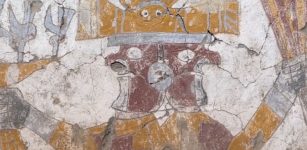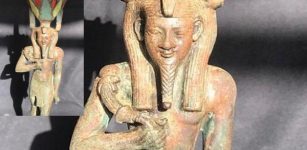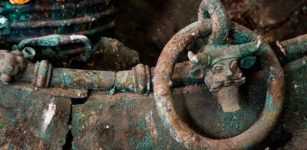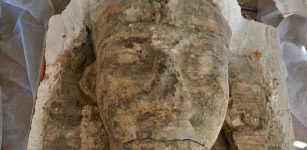Circe: Powerful Divine Sorceress Who Mastered Healing, Miracles And Transforming People Into Animals In Greek Mythology
A. Sutherland - AncientPages.com - One of many impressive and colorful figures in Greek mythology is Circe, a divine witch and goddess of incredible power. She had the ability to predict the future and transform people into animals. Circe was also a shape-shifter and performed cleansing rituals.
Left: Circe and Scylla in John William Waterhouse's Circe Invidiosa (1892) - Credit: Public Domain - Right: Circe on a 490–480 BC oil jar, Athens-National Archaeological Museum. Credit: Marsyas - CC BY-SA 2.5
She could turn people into animals, change the weather, had knowledge about healing herbs, and was skilled in spinning.
Although Circe performed many miracles, she was not immortal.
Daughter of Helios and Perse, an Oceanid, Circe was one of many divine magicians in her family, including Ariadne, Pasiphae, Angitia, Medea, and Hekate.
The daughter of the sun god Helios and a descendent of the sun, Circe's eyes shone with brilliant light, according to Homer's description. Also, Apollonius of Rhodes writes that she (just like every other descendant of Helios) had flashing golden eyes that shot out rays of light,
Homer wrote that Circe's dwelling was on the Isle of Aiaia (Aeaea) - the "Island of Dawn." She lived in a stunning marble palace in a forest clearing. Homer described her as "the fair-haired goddess," forever young and beautiful, who spent her days singing and weaving. The same habits are also associated with goddesses of fate and destiny in Roman and Slavic myths.
Unfortunately, despite her beautiful appearance, Circe - the owner of a magic wand – cannot be trusted and treated as an ordinary woman because she is a great sorceress. She could appear in any form and had positive and negative power over people.
Circe transforming men into pigs. Credit: Adobe Stock - Archivist
Her island of Aeaea was populated by beautiful handmaidens and tamed animals, including wolves and lions, which were humans under her spell.
Circe liked transforming male visitors into lions, baboons, and other animals, but mainly into pigs, her sacred animals.
Many famous appearances of Circe can be found in Greek mythology. In Homer's Odyssey, we also meet Circe, whose transformations are never accidental, and through them, she reveals the true animal identity within each man.
When Odysseus and his crew, trying to return home from the Trojan War, come to the island of Circe, they discover that the place's inhabitants are charming handmaidens and strange animals.
For the moment, all of them are under Circe's spell.
However, Odysseus alone is saved from this fate because Hermes, the messenger god sent by the goddess Athena, meets him. He reveals an herbal antidote to Circe's magic, a mysterious " moly " plant that can help defeat Circe and free his crew from their enchantment.
According to Homer's description of the plant, its root "was black, while the flower was as white as milk; the gods call it Moly, Dangerous for a mortal man to pluck from the soil, but not for the deathless gods. All lies within their power..."
It meant that when Circe touched Odysseus with her divine wand, he did not succumb to her power. Also, following Hermes's advice earlier, Odysseus threatened the sorceress with a sword that could kill her. It was enough for her, and she finally agreed to restore his companions to human form. She also hosted them for a month (or, in other versions, for a whole year). At the same time, Hermes advises Odysseus not to reject Circe's advances, so Odysseus decides to share a bed with her. He stays with her on the island for years, fathering their son, Telegonus.
As his primary trainer, Circe guides Odysseus into the secrets of shamanism, teaching him how to travel to Hades to interview dead souls and then return.
Thanks to the ability to foresee the future, the great sorceress offers Odysseus travel advice of great importance. Without her help, it's doubtful that Odysseus would ever have reached home in Ithaca.
Undoubtedly, Circe was often considered an attractive and seductive but ultimately dangerous woman. Still, we must remember that in Homer's original text, she is a helpful mythological figure.
Strabo writes that a tomb-shrine of Circe was attended in one of the Pharmacussae islands, located off the coast of Attica, a place associated with ancient hero worship. Circe was also worshiped in Mount Circeo, in the Italian peninsula, which took its name after her according to ancient legend.
Strabo also says that Circe had a shrine in the small town and that the people there kept a bowl they believed once belonged to Odysseus.
Her sacred plants included enchanter's nightshade, mandrakes, and junipers.
Written by – A. Sutherland - AncientPages.com Senior Staff Writer
Updated on January 5, 2024
Copyright © AncientPages.com All rights reserved. This material may not be published, broadcast, rewritten or redistributed in whole or part without thexpress written permission of AncientPages.com
More From Ancient Pages
-
 Ancient Murals Of Mysterious Two-Faced Beings And Supernatural Creatures At Pañamarca, Peru
Archaeology | Mar 21, 2023
Ancient Murals Of Mysterious Two-Faced Beings And Supernatural Creatures At Pañamarca, Peru
Archaeology | Mar 21, 2023 -
 Ancient Maya City And Pyramids Discovered In Mexican Jungle
Archaeology | Jun 24, 2023
Ancient Maya City And Pyramids Discovered In Mexican Jungle
Archaeology | Jun 24, 2023 -
 Carved Statue Of God Nefertum Unearthed In Egypt’s Saqqara Necropolis
Archaeology | Oct 3, 2020
Carved Statue Of God Nefertum Unearthed In Egypt’s Saqqara Necropolis
Archaeology | Oct 3, 2020 -
 1,300-Year-Old Church Discovered Near Mt. Tabor In Lower Galilee, Israel
Archaeology | Jul 28, 2020
1,300-Year-Old Church Discovered Near Mt. Tabor In Lower Galilee, Israel
Archaeology | Jul 28, 2020 -
 Bristol Academic Cracks Voynich Code – Century-Old Mystery Solved
Archaeology | May 15, 2019
Bristol Academic Cracks Voynich Code – Century-Old Mystery Solved
Archaeology | May 15, 2019 -
 Secrets Of The Famous Hellenistic-Era Kyrenia Shipwreck Revealed
Archaeology | Jun 28, 2024
Secrets Of The Famous Hellenistic-Era Kyrenia Shipwreck Revealed
Archaeology | Jun 28, 2024 -
 LIDAR Will ‘Map’ The Ground Surface To Reveal New Picture Of Ancient Native American Culture
Archaeology | Aug 18, 2023
LIDAR Will ‘Map’ The Ground Surface To Reveal New Picture Of Ancient Native American Culture
Archaeology | Aug 18, 2023 -
 Mystery Of The Lavau Celtic Prince And The Beautiful Ancient Artifacts Hidden In His 2,500-Year-Old Tomb
Archaeology | Jun 5, 2017
Mystery Of The Lavau Celtic Prince And The Beautiful Ancient Artifacts Hidden In His 2,500-Year-Old Tomb
Archaeology | Jun 5, 2017 -
 A Well-Preserved Lararium Shrine Discovered At Pompeii
Archaeology | Oct 10, 2018
A Well-Preserved Lararium Shrine Discovered At Pompeii
Archaeology | Oct 10, 2018 -
 Giant Blocks For Sphinx-Shaped King Amenhotep III Colossi Uncovered In Luxor, Egypt
Archaeology | Jan 23, 2022
Giant Blocks For Sphinx-Shaped King Amenhotep III Colossi Uncovered In Luxor, Egypt
Archaeology | Jan 23, 2022 -
 Rare Find Provides New Insight Into Etruscan Life Under Rome
Archaeology | Sep 3, 2022
Rare Find Provides New Insight Into Etruscan Life Under Rome
Archaeology | Sep 3, 2022 -
 Aluminum Was Used At Least 7,000 Years Ago – Long Before The Metal’s Official Invention In 1825
Ancient Technology | Jul 10, 2017
Aluminum Was Used At Least 7,000 Years Ago – Long Before The Metal’s Official Invention In 1825
Ancient Technology | Jul 10, 2017 -
 Lost Ancient Texts Of The Star Catalogue Composed By The Greek Astronomer Hipparchus Found
News | Feb 21, 2023
Lost Ancient Texts Of The Star Catalogue Composed By The Greek Astronomer Hipparchus Found
News | Feb 21, 2023 -
 Georgia Guidestones Damaged By An Explosive Device – By Whom And Why?
News | Jul 7, 2022
Georgia Guidestones Damaged By An Explosive Device – By Whom And Why?
News | Jul 7, 2022 -
 Underwater Drone Images Reveal Oldest Human-Made Structure In The Baltic Sea
Archaeology | Feb 13, 2024
Underwater Drone Images Reveal Oldest Human-Made Structure In The Baltic Sea
Archaeology | Feb 13, 2024 -
 Impressive And Rare Hoard Of Silver Coins Dated To The Hasmonean Period (126 BC) – Studied
Archaeology | Oct 14, 2021
Impressive And Rare Hoard Of Silver Coins Dated To The Hasmonean Period (126 BC) – Studied
Archaeology | Oct 14, 2021 -
 Ancient Pathogens Released From Melting Ice Could Wreak Havoc On The World – New Analysis Reveals
Featured Stories | Aug 2, 2023
Ancient Pathogens Released From Melting Ice Could Wreak Havoc On The World – New Analysis Reveals
Featured Stories | Aug 2, 2023 -
 Strange Ancient Abduction Case And Mysterious Journey To A Snake King’s Palace In A Parallel World
Ancient Mysteries | May 1, 2021
Strange Ancient Abduction Case And Mysterious Journey To A Snake King’s Palace In A Parallel World
Ancient Mysteries | May 1, 2021 -
 Denisovans Or Homo Sapiens: Who Were The First To Settle Permanently On The Tibetan Plateau?
Archaeology | Dec 9, 2021
Denisovans Or Homo Sapiens: Who Were The First To Settle Permanently On The Tibetan Plateau?
Archaeology | Dec 9, 2021 -
 31,000-Year-Old Skeleton Missing Foot May Show Oldest Amputation
Archaeology | Sep 7, 2022
31,000-Year-Old Skeleton Missing Foot May Show Oldest Amputation
Archaeology | Sep 7, 2022


